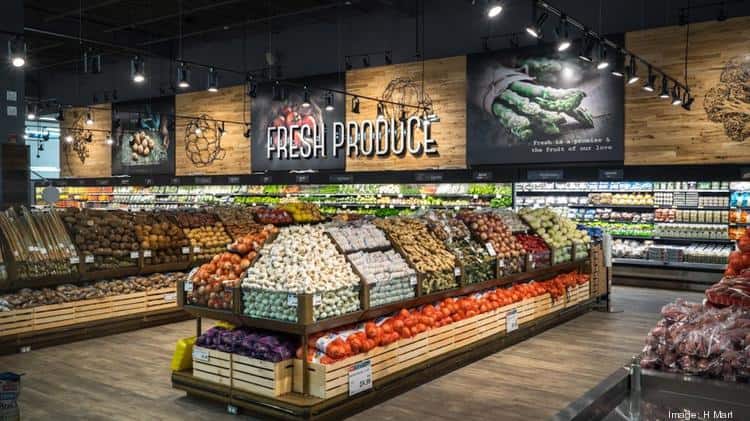May is celebrated as Asian American and Pacific Islander (AAPI) Heritage Month and is a time to recognize and celebrate the contributions of AAPI individuals to American culture and society. One area where AAPI communities have made significant impacts is in the grocery store industry. AAPI Heritage Month is a great time to explore the diverse offerings of AAPI-owned grocery stores and show support for these small businesses that are so important to their communities. Senior Project Manager Meghana Joshi reflects upon the cultural impacts of AAPI-owned grocery stores through the lens of literature and her personal experience as an AAPI designer.
————————————-
“[H Mart] is a beautiful, holy place. A cafeteria full of people from all over the world who have been displaced in a foreign country, each with a different history. Where did they come from? How far did they travel? Why are they all here? To find the galangal no American supermarket stocks to make the Indonesian curry their father loves? Maybe to buy the rice cakes to celebrate Jesa and honor the anniversary of the passing of their loved one? Perhaps to satisfy a craving for tteokbokki on a rainy day? Were they moved by a memory of some drunken, late-night snack under a pojangmacha tent in Incheon?”
– Michelle Zauner, Crying in H Mart
Michelle Zauner’s memoir is a tear-jerker based on the beautiful yet complicated dynamics of the relationship between an immigrant mother and her Korean American daughter, their relationship with food and identity, and their collective quest to belong. Aisles of H Mart, a Korean American supermarket chain, form a beautiful backdrop as the author explores food as a source of comfort and healing and asserting cultural identity. Emotional moments of the story weave through the produce section, hot food bars, and specialty items on a quest to find mental clarity in the organized spaces. Like the “difficult to find” ingredients within those aisles, Zauner addresses “difficult to express” grief of a Korean American daughter.

Food is a powerful love language for immigrants.
I am no stranger to this concept. I am the daughter of the diaspora, using food to create a sense of belonging and forging cultural identity. My story of cultural assimilation begins with the singular, lonely Safeway aisle in the San Francisco Bay area.
Our collective immigration experiences of the Chinese men working tirelessly to build the transcontinental railroad, or the Vietnamese women fleeing in fear of political persecution, or the Indian engineer who braved a new country for better opportunities in life were all encompassed by the Ethnic Foods sign adjacent to the sale area and restrooms. Under the fluorescent lights, this “section” was a small corner with Mahatma long grain rice, tired turmeric in plastic bags, clumpy saffron (that was neither Persian nor Spanish), and Cup Noodles that barely resembled the rich variety of noodle soups that populate East Asia. Nonetheless, it served the needs of a kitchen that created a home away from home.
“On a sticky August evening two weeks before her due date, Ashima Ganguli stands in the kitchen of a Central Square apartment, combining Rice Krispies and Planters peanuts and chopped red onion in a bowl. She adds salt, lemon juice, thin slices of green chili pepper, wishing there were mustard oil to pour into the mix. Ashima has been consuming this concoction throughout her pregnancy, a humble approximation of the snack sold for pennies on Calcutta sidewalks and on railway platforms throughout India, spilling from newspaper cones.”
– Jhumpa Lahiri, The Namesake
In this novel, Ashima Ganguly is an Indian immigrant who moves to America with her husband, Ashoke, to start a new life. Food and groceries play an important role in the narrative, as they serve as a way for Ashima to connect with her cultural identity and feel a sense of belonging in a new and unfamiliar place. At times, Ashima struggles to find the ingredients and flavors that she associates with home and, as a result feels a sense of otherness. However, she also finds comfort and familiarity in the foods she does find in American grocery stores and learns to adapt her cooking to the available ingredients.
Through Ashima’s experiences with food and groceries, the novel explores cultural identity, assimilation, and the challenges of navigating a new country and culture. Food and groceries serve as a metaphor for the ways in which immigrants must adapt and negotiate their sense of self in a new and unfamiliar environment.
As the Indian population grew during the dot-com boom, Indian grocery stores started to open their doors. The quality of architecture left a lot to be desired. When exiting, one seemingly compromised basic life and safety with food haphazardly stacked everywhere beyond the aisles, carts wobbled at one end, walls sported dusty decor, and storefronts decorated with old Indian sarees. But something about the smell of spices, salty Bedekar pickles and snacks, and Basmati rice kept bringing me back when I craved even the tiniest bit of home.
As an Indian, assimilation comes naturally to me. I’ve adapted to various cultures that have become a part of India throughout history. Even as we created our own chain of Patel grocery stores, we were busy recreating authentic Indian recipes using global ingredients found in the Safeway and Whole Foods aisles.
Today, Patel Brothers has more than fifty stores across America, and they have greatly improved the quality of their architecture and store design. They use the Whole Foods concept, with bins for pantry ingredients, fresh groceries along the walls, refrigerated aisles for ready-to-cook meals, and snacks and desserts near the check-out aisle. I appreciate how they’ve created a well-designed store that non-Indians can navigate to find Indian ingredients.
Globalization has resulted in the Americanization of retail, with many countries adapting to Western traditions and culture, such as fashion and trends. However, in the realm of food, there remains a strong connection to cultural heritage and diaspora. This is reflected in the architecture, design, and construction of grocery stores, which are deeply rooted in their local cultures and, yet, also a globalized version of themselves.

Grocery stores can be a powerful symbol of globalization as they are often a point of contact between cultures and economies. Through their products, marketing strategies, and design choices, grocery stores can reflect and shape the cultural and economic landscape of a region.
As architects and designers, we have the honor of partnering with clients such as H-Mart and Tokyo Central to uncover how customers can be immersed in cultures through their shopping experience. Senior Project Manager Randy Oleas adds, “Architectural design can enhance ethnic grocery stores by reflecting the cultural heritage of their customers through motifs, signage, and colors. Creating an intuitive layout that categorizes food types or cultural cuisine can help customers locate specific ingredients. Furthermore, providing spaces for cultural events and community engagement, such as cooking demonstrations or language classes, can transform the store into a hub for cultural exchange. Ultimately, such design choices can help create a more welcoming and culturally relevant space for customers.”
Want further proof of the positive strides AAPI-owned supermarkets are making in the grocery industry? Cookly Magazine recently named H Mart to its list of Best Grocery Stores in the United States!

